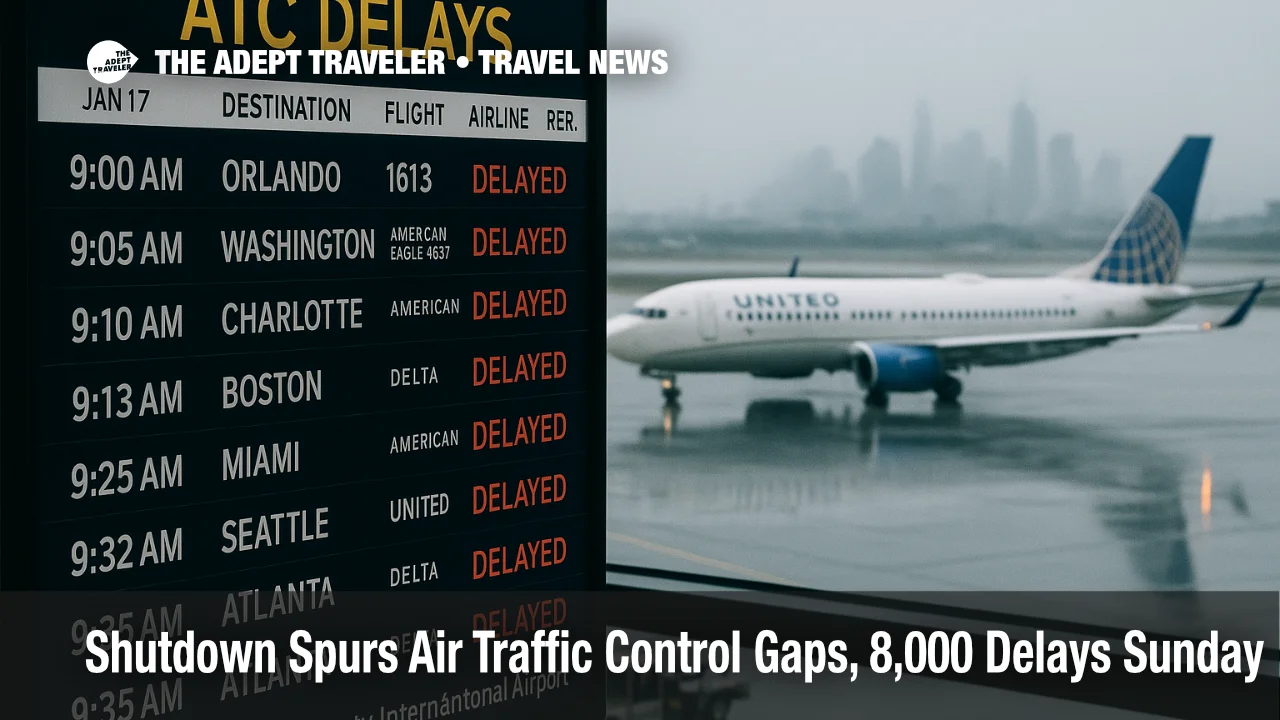Shutdown Spurs ATC Gaps, 8,000 Delays on Sunday

Key points
- Controller absences tied to the government shutdown caused more than 8,600 U.S. flight delays on Sunday
- FAA reported staffing issues at 22 facilities leading to delays and cancellations
- As of Monday 8:20 a.m. ET more than 800 U.S. flights were delayed and about 360 were canceled
- Ground stops were issued at Houston IAH and Newark EWR with significant delays at Washington DCA and New York LGA
- About 13,000 air traffic controllers and 50,000 TSA officers are working without pay
- Officials warn disruptions could worsen into the holiday season citing 2019 shutdown impacts
Impact
- What Changed
- Shutdown-driven controller absences triggered nationwide delay programs and sporadic ground stops
- Where Impacts Are Concentrated
- New York area Washington Houston and Newark with ripple effects across major hubs
- Why It Matters
- Reduced arrival rates and staffing shortfalls increase the risk of rolling delays and missed connections
- Who Is Affected
- Airline passengers nationwide especially those with tight connections at congested airports
- Outlook
- Disruptions likely to persist and potentially intensify until federal funding resumes
- Travel Advice
- Monitor airline apps rebook to earlier nonstop flights when possible and allow extra time for security
A prolonged U.S. government shutdown is rippling through commercial aviation as air traffic control, ATC, facilities report rising absenteeism and fatigue among personnel working without pay. On October 26, 2025, FlightAware tallied more than 8,600 delays across the United States. By Monday morning, October 27, delays were mounting again as the Federal Aviation Administration, FAA, used traffic-management programs to slow arrivals at key hubs. For travelers, the upshot is longer taxi-out queues, reduced arrival rates, and sporadic ground stops that can cascade into missed connections.
Federal Aviation Administration (FAA)
The FAA confirmed multiple staffing "triggers" over the weekend and into Monday, including a temporary ground stop for Los Angeles International Airport, along with recent ground actions at George Bush Intercontinental in Houston and Newark Liberty outside New York. Washington's Reagan National and New York's LaGuardia also reported significant delays on peak days. The agency reiterated that when staffing dips below safe thresholds, it spaces flights farther apart and meters arrivals, which preserves safety but reduces capacity.
Latest developments
Transportation Secretary Sean Duffy said on Saturday that ATC staffing shortfalls were recorded at 22 locations, among the highest daily counts since the shutdown began on October 1. On Sunday, the system absorbed more than 8,600 delays nationwide, followed by a fresh wave Monday that crossed 1,600 by midday. Some days during the shutdown have seen an unusually high share of delays attributed directly to controller absences, far above normal baselines. While weather and equipment issues still contribute to disruption, the present constraint is the availability of certified controllers to fully staff facilities, particularly approach controls in busy metro areas.
Analysis
For travelers, the pattern is clear: reduced arrival rates at ATC facilities translate to slower-than-scheduled operations even in clear weather. Because the constraint is staffing, not runway condition, delays can pop up with little notice and persist beyond local storms. To preserve connection buffers, book longer layovers than usual, choose earlier bank times, and favor nonstop flights to eliminate misconnect risk. If you are already ticketed, monitor airline apps closely and consider moving to flights earlier in the day, when recovery options are more numerous.
Airlines and airports cannot control ATC staffing, but they can help you work around it. Many carriers are waiving same-day change fees when delay programs are in effect. If you are traveling this week, check for a proactive change option in your booking, verify minimum connection times, and download your airline's mobile app for push alerts. When a ground stop or ground delay program is underway at your origin or connection, expect gate holds, aircraft swaps, and crew-time constraints that can ripple beyond the affected city.
Background
ATC facilities are staffed by certified professional controllers who handle specific slices of airspace, from en-route centers to terminal approach control. When a shutdown suspends pay across key agencies, including the FAA and the Transportation Security Administration, staff must still report to duty, but the rate of call-outs typically rises as financial strain grows. To keep safety margins intact, the FAA reduces the number of aircraft handled per hour. That preserves separation but creates delays and missed connections downstream. During the 35-day shutdown in 2019, a spike in absences forced New York-area traffic to be slowed, which in turn pressured lawmakers to resolve funding; current conditions are trending in that direction as the holiday travel window approaches.
If you want a day-by-day look at where delays are clustering, our rolling coverage in Flight Delays and Airport Impacts: October 27, 2025 tracks FAA programs and airline advisories in one place.
Final thoughts
The government shutdown is now a primary driver of flight disruption in the U.S., and its operational effects are most visible in ATC-related delay programs. Until funding resumes, travelers should plan for extended block times, protect connections, and stay flexible on routing. Keep ATC staffing and "shutdown" in mind as you evaluate schedules for the next few weeks.
Sources
- More Than 8,000 U.S. Flights Delayed as ATC Absences Persist, Reuters
- Flight Delays Top 1,660 Monday After 8,600 Sunday, Reuters
- FAA Statement on Air Traffic Controller Staffing, FAA
- LAX-Bound Flights Temporarily Halted Sunday, Associated Press
- White House Warns of Holiday Impacts if Shutdown Persists, Reuters
- ATC Staffing Issues Delaying Flights in New York, Washington, Newark, and Houston, Reuters
- 2019 Shutdown Context on ATC Absences and Delays, Reuters
